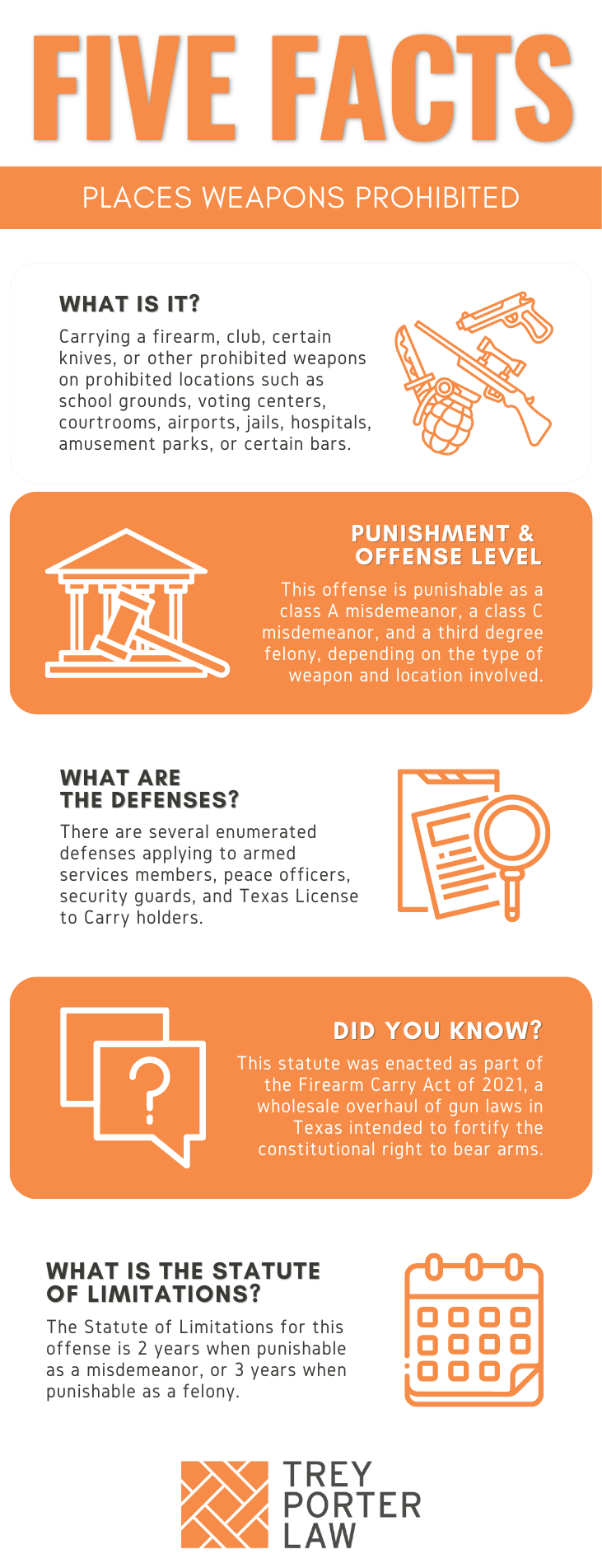WHAT IS THE OFFENSE OF PLACES WEAPONS PROHIBITED IN TEXAS?
In Texas, anyone 21 years of age or older who can legally possess a firearm may carry openly or concealed in any place not expressly prohibited by law. The Texas law against places weapons prohibited makes it a crime to bring a firearm, club, knife with a blade over five and a half inches, or other prohibited weapon:
- on school grounds, premises of an educational institution, a school bus, or any place where a school activity is being conducted, unless a person has written authorization;
- into a college or institution of higher education, unless the person has written authorization, or is licensed to carry a concealed handgun, and does not openly display the gun;
- into a polling place on election day or during early voting;
- into any government court or court offices, unless a person has written authorization;
- into a racetrack facility for betting on horses or greyhounds;
- into the secured area of an airport;
- within 1,000 feet of a designated place of execution on the inmate’s execution date, as long as the person was given notice, and were not merely traveling on a public road, or at their residence or workplace;
- into a bar, or other place that derives at least 51% of its income from the sale of alcoholic beverages for on-premises consumption;
- on premises where a high school, college, or professional sporting or interscholastic event is taking place, unless the person is a participant in the event, and the prohibited weapon is used in the event;
- into a correctional facility;
- into a hospital or nursing facility, unless a person has written authorization;
- into a mental hospital, unless a person has written authorization;
- into an amusement park;
- into a room used for an open government meeting;
WHAT IS THE PLACES WEAPONS PROHIBITED LAW IN TEXAS?
Tex. Penal Code § 46.03. PLACES WEAPONS PROHIBITED.
(a) A person commits an offense if the person intentionally, knowingly, or recklessly possesses or goes with a firearm, location-restricted knife, club, or prohibited weapon listed in Section 46.05(a):
(1) on the physical premises of a school or educational institution, any grounds or building on which an activity sponsored by a school or educational institution is being conducted, or a passenger transportation vehicle of a school or educational institution, whether the school or educational institution is public or private, unless:
(A) pursuant to written regulations or written authorization of the institution; or
(B) the person possesses or goes with a concealed handgun that the person is licensed to carry under Subchapter H, Chapter 411, Government Code, and no other weapon to which this section applies, on the premises of an institution of higher education or private or independent institution of higher education, on any grounds or building on which an activity sponsored by the institution is being conducted, or in a passenger transportation vehicle of the institution;
(2) on the premises of a polling place on the day of an election or while early voting is in progress;
(3) on the premises of any government court or offices utilized by the court, unless pursuant to written regulations or written authorization of the court;
(4) on the premises of a racetrack;
(5) in or into a secured area of an airport;
(6) within 1,000 feet of premises the location of which is designated by the Texas Department of Criminal Justice as a place of execution under Article 43.19, Code of Criminal Procedure, on a day that a sentence of death is set to be imposed on the designated premises and the person received notice that:
(A) going within 1,000 feet of the premises with a weapon listed under this subsection was prohibited; or
(B) possessing a weapon listed under this subsection within 1,000 feet of the premises was prohibited;
(7) on the premises of a business that has a permit or license issued under Chapter 25, 28, 32, 69, or 74, Alcoholic Beverage Code, if the business derives 51 percent or more of its income from the sale or service of alcoholic beverages for on-premises consumption, as determined by the Texas Alcoholic Beverage Commission under Section 104.06, Alcoholic Beverage Code;
(8) on the premises where a high school, collegiate, or professional sporting event or interscholastic event is taking place, unless the person is a participant in the event and a firearm, location-restricted knife, club, or prohibited weapon listed in Section 46.05(a) is used in the event;
(9) on the premises of a correctional facility;
(10) on the premises of a civil commitment facility;
(11) on the premises of a hospital licensed under Chapter 241, Health and Safety Code, or on the premises of a nursing facility licensed under Chapter 242, Health and Safety Code, unless the person has written authorization of the hospital or nursing facility administration, as appropriate;
(12) on the premises of a mental hospital, as defined by Section 571.003, Health and Safety Code, unless the person has written authorization of the mental hospital administration;
(13) in an amusement park; or
(14) in the room or rooms where a meeting of a governmental entity is held, if the meeting is an open meeting subject to Chapter 551, Government Code, and if the entity provided notice as required by that chapter.
(a-2) Notwithstanding Section 46.02(a-5), a license holder commits an offense if the license holder carries a partially or wholly visible handgun, regardless of whether the handgun is holstered, on or about the license holder’s person under the authority of Subchapter H, Chapter 411, Government Code, and intentionally or knowingly displays the handgun in plain view of another person:
(1) on the premises of an institution of higher education or private or independent institution of higher education; or
(2) on any public or private driveway, street, sidewalk or walkway, parking lot, parking garage, or other parking area of an institution of higher education or private or independent institution of higher education.
(a-3) Notwithstanding Subsection (a) or Section 46.02(a-5), a license holder commits an offense if the license holder carries a handgun on the campus of a private or independent institution of higher education in this state that has established rules, regulations, or other provisions prohibiting license holders from carrying handguns pursuant to Section 411.2031(e), Government Code, or on the grounds or building on which an activity sponsored by such an institution is being conducted, or in a passenger transportation vehicle of such an institution, regardless of whether the handgun is concealed, provided the institution gives effective notice under Section 30.06.
(a-4) Notwithstanding Subsection (a) or Section 46.02(a-5), a license holder commits an offense if the license holder intentionally carries a concealed handgun on a portion of a premises located on the campus of an institution of higher education in this state on which the carrying of a concealed handgun is prohibited by rules, regulations, or other provisions established under Section 411.2031(d-1), Government Code, provided the institution gives effective notice under Section 30.06 with respect to that portion.
(b) It is a defense to prosecution under Subsections (a)(1)-(4) that the actor possessed a firearm while in the actual discharge of his official duties as a member of the armed forces or national guard or a guard employed by a penal institution, or an officer of the court.
(d) It is a defense to prosecution under Subsection (a)(5) that the actor possessed a firearm or club while traveling to or from the actor’s place of assignment or in the actual discharge of duties as:
(1) a member of the armed forces or national guard;
(2) a guard employed by a penal institution; or
(3) a security officer commissioned by the Texas Private Security Board if:
(A) the actor is wearing a distinctive uniform; and
(B) the firearm or club is in plain view; or
(4) a security officer who holds a personal protection authorization under Chapter 1702, Occupations Code, provided that the officer is either:
(A) wearing the uniform of a security officer, including any uniform or apparel described by Section 1702.323(d), Occupations Code, and carrying the officer’s firearm in plain view; or
(B) not wearing the uniform of a security officer and carrying the officer’s firearm in a concealed manner.
(e) It is a defense to prosecution under Subsection (a)(5) that the actor:
(1) checked all firearms as baggage in accordance with federal or state law or regulations before entering a secured area; or
(2) was authorized by a federal agency or the airport operator to possess a firearm in a secured area.
(e-1) It is a defense to prosecution under Subsection (a)(5) that the actor:
(1) possessed, at the screening checkpoint for the secured area, a handgun that the actor was licensed to carry under Subchapter H, Chapter 411, Government Code; and
(2) exited the screening checkpoint for the secured area immediately upon completion of the required screening processes and notification that the actor possessed the handgun.
(e-2) A peace officer investigating conduct that may constitute an offense under Subsection (a)(5) and that consists only of an actor’s possession of a handgun that the actor is licensed to carry under Subchapter H, Chapter 411, Government Code, may not arrest the actor for the offense unless:
(1) the officer advises the actor of the defense available under Subsection (e-1) and gives the actor an opportunity to exit the screening checkpoint for the secured area; and
(2) the actor does not immediately exit the checkpoint upon completion of the required screening processes.
(f) Except as provided by Subsection (e-1), it is not a defense to prosecution under this section that the actor possessed a handgun and was licensed to carry a handgun under Subchapter H, Chapter 411, Government Code.
(g) Except as provided by Subsections (g-1) and (g-2), an offense under this section is a felony of the third degree.
(g-1) If the weapon that is the subject of the offense is a location-restricted knife, an offense under this section is a Class C misdemeanor, except that the offense is a felony of the third degree if the offense is committed under Subsection (a)(1).
(g-2) An offense committed under Subsection (a)(8), (a)(10), (a)(11), (a)(13), (a-2), (a-3), or (a-4) is a Class A misdemeanor.
(h) It is a defense to prosecution under Subsection (a)(4) that the actor possessed a firearm or club while traveling to or from the actor’s place of assignment or in the actual discharge of duties as a security officer commissioned by the Texas Board of Private Investigators and Private Security Agencies, if:
(1) the actor is wearing a distinctive uniform; and
(2) the firearm or club is in plain view.
(i) It is an exception to the application of Subsection (a)(6) that the actor possessed a firearm or club:
(1) while in a vehicle being driven on a public road; or
(2) at the actor’s residence or place of employment.
Tex. Penal Code § 46.15. NONAPPLICABILITY.
(a) Sections 46.02 and 46.03 do not apply to:
(1) peace officers or special investigators under Article 2.122, Code of Criminal Procedure, and neither section prohibits a peace officer or special investigator from carrying a weapon in this state, including in an establishment in this state serving the public, regardless of whether the peace officer or special investigator is engaged in the actual discharge of the officer’s or investigator’s duties while carrying the weapon;
(2) parole officers, and neither section prohibits an officer from carrying a weapon in this state if the officer is:
(A) engaged in the actual discharge of the officer’s duties while carrying the weapon; and
(B) in compliance with policies and procedures adopted by the Texas Department of Criminal Justice regarding the possession of a weapon by an officer while on duty;
(3) community supervision and corrections department officers appointed or employed under Section 76.004, Government Code, and neither section prohibits an officer from carrying a weapon in this state if the officer is:
(A) engaged in the actual discharge of the officer’s duties while carrying the weapon; and
(B) authorized to carry a weapon under Section 76.0051, Government Code;
(4) an active judicial officer as defined by Section 411.201, Government Code, who is licensed to carry a handgun under Subchapter H, Chapter 411, Government Code;
(5) an honorably retired peace officer or other qualified retired law enforcement officer, as defined by 18 U.S.C. Section 926C, who holds a certificate of proficiency issued under Section 1701.357, Occupations Code, and is carrying a photo identification that is issued by a federal, state, or local law enforcement agency, as applicable, and that verifies that the officer is an honorably retired peace officer or other qualified retired law enforcement officer;
(6) the attorney general or a United States attorney, district attorney, criminal district attorney, county attorney, or municipal attorney who is licensed to carry a handgun under Subchapter H, Chapter 411, Government Code;
(7) an assistant United States attorney, assistant attorney general, assistant district attorney, assistant criminal district attorney, or assistant county attorney who is licensed to carry a handgun under Subchapter H, Chapter 411, Government Code;
(8) a bailiff designated by an active judicial officer as defined by Section 411.201, Government Code, who is:
(A) licensed to carry a handgun under Subchapter H, Chapter 411, Government Code; and
(B) engaged in escorting the judicial officer;
(9) a juvenile probation officer who is authorized to carry a firearm under Section 142.006, Human Resources Code; or
(10) a person who is volunteer emergency services personnel if the person is:
(A) carrying a handgun under the authority of Subchapter H, Chapter 411, Government Code; and
(B) engaged in providing emergency services.
(b) Sections 46.02, 46.03(a)(14), and 46.04(a-1) do not apply to a person who:
(1) is in the actual discharge of official duties as a member of the armed forces or state military forces as defined by Section 437.001, Government Code, or as a guard employed by a penal institution;
(2) is traveling;
(3) is engaging in lawful hunting, fishing, or other sporting activity on the immediate premises where the activity is conducted, or is en route between the premises and the actor’s residence, motor vehicle, or watercraft, if the weapon is a type commonly used in the activity;
(4) holds a security officer commission issued by the Texas Private Security Board, if the person is engaged in the performance of the person’s duties as an officer commissioned under Chapter 1702, Occupations Code, or is traveling to or from the person’s place of assignment and is wearing the officer’s uniform and carrying the officer’s weapon in plain view;
(5) acts as a personal protection officer and carries the person’s security officer commission and personal protection officer authorization, if the person:
(A) is engaged in the performance of the person’s duties as a personal protection officer under Chapter 1702, Occupations Code, or is traveling to or from the person’s place of assignment; and
(B) is either:
(i) wearing the uniform of a security officer, including any uniform or apparel described by Section 1702.323(d), Occupations Code, and carrying the officer’s weapon in plain view; or
(ii) not wearing the uniform of a security officer and carrying the officer’s weapon in a concealed manner;
(6) is carrying:
(A) a license issued under Subchapter H, Chapter 411, Government Code, to carry a handgun; and
(B) a handgun:
(i) in a concealed manner; or
(ii) in a holster;
(7) holds an alcoholic beverage permit or license or is an employee of a holder of an alcoholic beverage permit or license if the person is supervising the operation of the permitted or licensed premises; or
(8) is a student in a law enforcement class engaging in an activity required as part of the class, if the weapon is a type commonly used in the activity and the person is:
(A) on the immediate premises where the activity is conducted; or
(B) en route between those premises and the person’s residence and is carrying the weapon unloaded.
. . .
(d) The provisions of Section 46.02 prohibiting the carrying of a firearm do not apply to a public security officer employed by the adjutant general under Section 437.053, Government Code, in performance of official duties or while traveling to or from a place of duty.
(e) Section 46.02(a-4) does not apply to an individual carrying a location-restricted knife used in a historical demonstration or in a ceremony in which the knife is significant to the performance of the ceremony.
(f) Section 46.03(a)(6) does not apply to a person who possesses a firearm or club while in the actual discharge of official duties as:
(1) a member of the armed forces or state military forces, as defined by Section 437.001, Government Code; or
(2) an employee of a penal institution.
(g) The provisions of Section 46.03 prohibiting the possession or carrying of a club do not apply to an animal control officer who holds a certificate issued under Section 829.006, Health and Safety Code, and who possesses or carries an instrument used specifically for deterring the bite of an animal while the officer is in the performance of official duties under the Health and Safety Code or is traveling to or from a place of duty.
(h) The provisions of Section 46.03 prohibiting the possession or carrying of a club do not apply to a code enforcement officer who:
(1) holds a certificate of registration issued under Chapter 1952, Occupations Code; and
(2) possesses or carries an instrument used specifically for deterring an animal bite while the officer is:
(A) performing official duties; or
(B) traveling to or from a place of duty.
. . .
(j) The provisions of Sections 46.02 and 46.03(a)(7), (a-2), (a-3), and (a-4) do not apply to an individual who carries a handgun as a participant in a historical reenactment performed in accordance with the rules of the Texas Alcoholic Beverage Commission.
(k) Section 46.02 does not apply to a person who carries a handgun if:
(1) the person carries the handgun while:
(A) evacuating from an area following the declaration of a state of disaster under Section 418.014, Government Code, or a local state of disaster under Section 418.108, Government Code, with respect to that area; or
(B) reentering that area following the person’s evacuation;
(2) not more than 168 hours have elapsed since the state of disaster or local state of disaster was declared, or more than 168 hours have elapsed since the time the declaration was made and the governor has extended the period during which a person may carry a handgun under this subsection; and
(3) the person is not prohibited by state or federal law from possessing a firearm.
(l) Sections 46.02 and 46.03(a)(1), (a)(2), (a)(3), and (a)(4) do not apply to a person who carries a handgun if:
(1) the person carries the handgun on the premises, as defined by the statute providing the applicable offense, of a location operating as an emergency shelter during a state of disaster declared under Section 418.014, Government Code, or a local state of disaster declared under Section 418.108, Government Code;
(2) the owner, controller, or operator of the premises or a person acting with the apparent authority of the owner, controller, or operator, authorized the carrying of the handgun;
(3) the person carrying the handgun complies with any rules and regulations of the owner, controller, or operator of the premises that govern the carrying of a handgun on the premises; and
(4) the person is not prohibited by state or federal law from possessing a firearm.
<Text of (m), as added by Acts 2021, 87th Leg., ch. 809 (H.B. 1927), § 25>
(m) It is a defense to prosecution under Section 46.03 that the actor:
(1) carries a handgun on a premises or other property on which the carrying of a weapon is prohibited under that section;
(2) personally received from the owner of the property, or from another person with apparent authority to act for the owner, notice that carrying a firearm or other weapon on the premises or other property, as applicable, was prohibited; and
(3) promptly departed from the premises or other property.
<Text of (m), as added by Acts 2021, 87th Leg., ch. 1026 (H.B. 1069), § 8>
(m) Sections 46.02, 46.03, and 46.035(b) and (c) do not apply to a first responder who:
(1) was carrying a handgun in a concealed manner or in a shoulder or belt holster;
(2) holds an unexpired certificate of completion under Section 411.184, Government Code, at the time of engaging in the applicable conduct;
(3) was engaged in the actual discharge of the first responder’s duties while carrying the handgun; and
(4) was employed or supervised by a municipality or county to which Chapter 179, Local Government Code, applies.
(n) The defense provided by Subsection (m) does not apply if:
(1) a sign described by Subsection (o) was posted prominently at each entrance to the premises or other property, as applicable; or
(2) at the time of the offense, the actor knew that carrying a firearm or other weapon on the premises or other property was prohibited.
(o) A person may provide notice that firearms and other weapons are prohibited under Section 46.03 on the premises or other property, as applicable, by posting a sign at each entrance to the premises or other property that:
(1) includes language that is identical to or substantially similar to the following: “Pursuant to Section 46.03, Penal Code (places weapons prohibited), a person may not carry a firearm or other weapon on this property”;
(2) includes the language described by Subdivision (1) in both English and Spanish;
(3) appears in contrasting colors with block letters at least one inch in height; and
(4) is displayed in a conspicuous manner clearly visible to the public.
(p) Sections 46.03(a)(7), (11), and (13) do not apply if the actor:
(1) carries a handgun on the premises or other property, as applicable;
(2) holds a license to carry a handgun issued under Subchapter H, Chapter 411, Government Code; and
(3) was not given effective notice under Section 30.06 or 30.07 of this code or Section 411.204, Government Code, as applicable.
(q) Section 46.03(a)(8) does not apply if the actor:
(1) carries a handgun on a premises where a collegiate sporting event is taking place;
(2) holds a license to carry a handgun issued under Subchapter H, Chapter 411, Government Code; and
(3) was not given effective notice under Section 30.06 or 30.07 of this code, as applicable.
WHAT IS THE PENALTY CLASS FOR PLACES WEAPONS PROHIBITED IN TEXAS?
The penalty category for possessing a weapon in a prohibited place depends on the specific prohibited location, and the prohibited weapon the person carries.
Possessing a weapon in a prohibited place is a Class C misdemeanor, punishable by a maximum fine of $500, if the weapon is a knife with a blade over five and a half inches. However, if the location-restricted knife is brought onto school grounds or a school bus, it is a third degree felony.
Possessing a weapon in a prohibited place is also a Class A misdemeanor if a person brings any prohibited weapon:
- on premises where a high school, college, or professional sporting or interscholastic event is taking place, unless the person is a participant in the event, and the prohibited weapon is used in the event;
- into a hospital or nursing facility, unless a person has written authorization;
- into an amusement park;
- onto a college campus or institution of higher education, if the person holds a license to carry, but the institution gave effective notice that guns on campus were prohibited;
- onto a college campus or institution of higher education, if the person holds a license to carry, but carries the weapon openly.
Possessing a weapon in a prohibited place is a third degree felony, punishable by two to ten years in prison, if a person brings any prohibited weapon:
- on school grounds, premises of an educational institution, a school bus, or any place where a school activity is being conducted, unless a person has written authorization;
- institution of higher education, unless the person has written authorization, or is licensed to carry a concealed handgun;
- into a polling place on election day or during early voting;
- into any government court or court offices, unless a person has written authorization;
- into a racetrack facility for betting on horses or greyhounds;
- into the secured area of an airport;
- within 1,000 feet of a designated place of execution on the inmate’s execution date, as long as the person was given notice, and were not merely traveling on a public road, or at their residence or workplace;
- into a bar, or other place that derives at least 51% of its income from the sale of alcoholic beverages for on-premises consumption;
- into a correctional facility;
- into a mental hospital, unless a person has written authorization;
- into a room used for an open government meeting.
Texas Penal Code Section 46.11 increases the punishment to the next highest category if the person committed a weapons offense within 300 feet of a school, or on premises where a school function or an event sponsored by the University Scholastic League is taking place. This section does not apply to a person charged with bringing a handgun on school premises under 46.03(a)(1).
WHAT IS THE PUNISHMENT RANGE FOR PLACES WEAPONS PROHIBITED IN TEXAS?
The punishment range for possessing a weapon in a prohibited place charged as a Class C misdemeanor is a maximum fine of $500. If charged as a Class A misdemeanor, it carries a maximum jail sentence of one year, and up to a $4,000 fine. Possession of a weapon in a prohibited place categorized as a third degree felony carries between two and ten years in prison, and a maximum fine of $10,000.
WHAT ARE THE PENALTIES FOR PLACES WEAPONS PROHIBITED IN TEXAS?
A person charged with possessing a weapon in prohibited place may be eligible for probation after a conviction, or deferred adjudication without a conviction. The maximum period of community supervision for a Class A misdemeanor is two years, and ten years for a third degree felony. If charged with a Class C misdemeanor, a person may receive deferred adjudication for up to 180 days.
WHAT ARE THE DEFENSES TO PLACES WEAPONS PROHIBITED IN TEXAS?
The places weapons prohibited law authorizes several defenses in addition to those listed in Section 46.15. For example, members of the armed forces or national guard, or a guard employed by a penal institution who are discharging their official duties may raise a defense if they are arrested for carrying a firearm in a prohibited place. Another defense is available for security officers who are arrested openly carrying a firearm or club at a racetrack, while in uniform, if they show they were traveling to or from a place of assignment or discharging duties as a security officer.
- Can a person with a license to carry a handgun carry into the prohibited places? A person with a license to carry (“LTC”) is not exempt from the law prohibiting weapons in certain protected places. However, the statute permits LTC holders to carry a concealed handgun onto school grounds, college campuses, and any other institution of higher education, unless the campus or institution provides effective notice under Section 30.06 that firearms are prohibited. Even where they are allowed to carry, LTC holders must carry concealed on campus grounds and the surrounding outdoor areas, such as parking lots and sidewalks. Displaying a handgun on campus is a Class A misdemeanor.
- May a listed prohibited place allow firearms on the premises? Government courts and court offices, schools, hospitals, and nursing facilities may permit weapons on premises, through their written regulations or other written authorization. The other locations listed in the statute may not circumvent the weapons prohibition.
- Are guns and other weapons still prohibited inside the airport? Yes, but the law creates defenses, which may be raised and proved at a person’s trial for possessing a prohibited weapon in a secured area of an airport. The statute gives LTC holders a defense if they exit the screening checkpoint immediately upon being notified of the handgun in their possession, and prohibits police from arresting them prior to giving them the opportunity to exit the area. Additional defenses are available for:
-
- travelers who check all firearms as baggage prior to entering the secured area, or were authorized by a federal agency or airport operator to carry a firearm;
- security officers, members of the armed forces or national guard, or guards employed by a penal institution who openly carry a firearm or club while traveling to or from their place of assignment, or discharging duties, and are in uniform;
- security officers with personal protection authorization, who either openly carry a firearm while in uniform, or concealed carry a firearm if not in uniform.
WHAT IS THE STATUTE OF LIMITATIONS FOR PLACES WEAPONS PROHIBITED IN TEXAS?
The limitation for places weapons prohibited categorized as a Class A or Class C misdemeanor is two years. For a third degree felony, the limitation period is three years.
PLACES WEAPONS PROHIBITED IN TEXAS
Texas lawmakers enacted the Firearm Carry Act of 2021 to protect the right to keep and bear arms, and to use firearms for traditionally lawful purposes. Although Texans may possess firearms and carry handguns without a license, Texas law retains the licensing provisions as optional for reciprocity with other states that have yet to pass similar legislation.
TEXAS PLACES WEAPONS PROHIBITED COURT CASES
The case law regarding places weapons prohibited in Texas interprets the laws prior to the 2021 overhaul.
The Seventh Court of Appeals recently refused to decide whether a sign excluding firearms from the Waller County Courthouse, violated Government Code Section 411.209, which penalizes state agencies and political subdivisions for excluding LTC holders from carrying handguns on certain premises not listed in the Penal Code. Section 46.03(a)(3) only bars carrying weapons into a courtroom and court offices, not the entire building, but the appellate court held the Attorney General suing Waller County failed to allege a violation of the wrongful exclusion statute. Waller County v. Paxton, No. 07-22-00034-CV (Tex. App.—Amarillo Aug. 17, 2022, no pet.).
The Attorney General also sued the City of Austin for wrongful exclusion after LTC holders were prohibited from carrying handguns into City Hall in 2015. The trial court assessed civil penalties against the City, which were upheld on appeal. Paxton v. City of Austin, No. 03-19-00501-CV (Tex. App—Austin July 22, 2021, pet. denied).

















